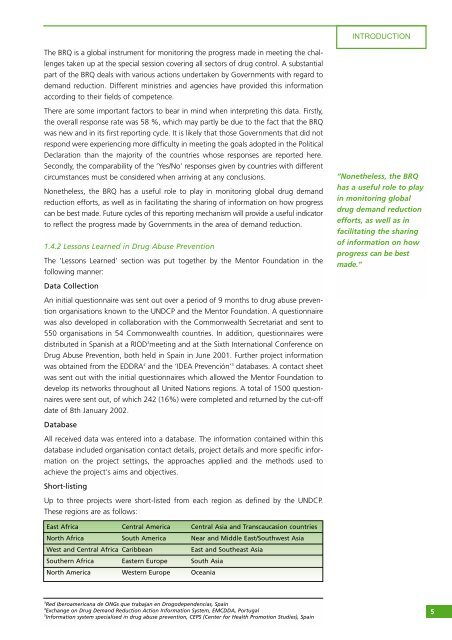PDF (Lessons learned in drug abuse prevention: a global review)
PDF (Lessons learned in drug abuse prevention: a global review)
PDF (Lessons learned in drug abuse prevention: a global review)
Create successful ePaper yourself
Turn your PDF publications into a flip-book with our unique Google optimized e-Paper software.
INTRODUCTION<br />
The BRQ is a <strong>global</strong> <strong>in</strong>strument for monitor<strong>in</strong>g the progress made <strong>in</strong> meet<strong>in</strong>g the challenges<br />
taken up at the special session cover<strong>in</strong>g all sectors of <strong>drug</strong> control. A substantial<br />
part of the BRQ deals with various actions undertaken by Governments with regard to<br />
demand reduction. Different m<strong>in</strong>istries and agencies have provided this <strong>in</strong>formation<br />
accord<strong>in</strong>g to their fields of competence.<br />
There are some important factors to bear <strong>in</strong> m<strong>in</strong>d when <strong>in</strong>terpret<strong>in</strong>g this data. Firstly,<br />
the overall response rate was 58 %, which may partly be due to the fact that the BRQ<br />
was new and <strong>in</strong> its first report<strong>in</strong>g cycle. It is likely that those Governments that did not<br />
respond were experienc<strong>in</strong>g more difficulty <strong>in</strong> meet<strong>in</strong>g the goals adopted <strong>in</strong> the Political<br />
Declaration than the majority of the countries whose responses are reported here.<br />
Secondly, the comparability of the ‘Yes/No’ responses given by countries with different<br />
circumstances must be considered when arriv<strong>in</strong>g at any conclusions.<br />
Nonetheless, the BRQ has a useful role to play <strong>in</strong> monitor<strong>in</strong>g <strong>global</strong> <strong>drug</strong> demand<br />
reduction efforts, as well as <strong>in</strong> facilitat<strong>in</strong>g the shar<strong>in</strong>g of <strong>in</strong>formation on how progress<br />
can be best made. Future cycles of this report<strong>in</strong>g mechanism will provide a useful <strong>in</strong>dicator<br />
to reflect the progress made by Governments <strong>in</strong> the area of demand reduction.<br />
1.4.2 <strong>Lessons</strong> Learned <strong>in</strong> Drug Abuse Prevention<br />
The ‘<strong>Lessons</strong> Learned’ section was put together by the Mentor Foundation <strong>in</strong> the<br />
follow<strong>in</strong>g manner:<br />
Data Collection<br />
An <strong>in</strong>itial questionnaire was sent out over a period of 9 months to <strong>drug</strong> <strong>abuse</strong> <strong>prevention</strong><br />
organisations known to the UNDCP and the Mentor Foundation. A questionnaire<br />
was also developed <strong>in</strong> collaboration with the Commonwealth Secretariat and sent to<br />
550 organisations <strong>in</strong> 54 Commonwealth countries. In addition, questionnaires were<br />
distributed <strong>in</strong> Spanish at a RIOD 3 meet<strong>in</strong>g and at the Sixth International Conference on<br />
Drug Abuse Prevention, both held <strong>in</strong> Spa<strong>in</strong> <strong>in</strong> June 2001. Further project <strong>in</strong>formation<br />
was obta<strong>in</strong>ed from the EDDRA 4 and the ‘IDEA Prevención’ 5 databases. A contact sheet<br />
was sent out with the <strong>in</strong>itial questionnaires which allowed the Mentor Foundation to<br />
develop its networks throughout all United Nations regions. A total of 1500 questionnaires<br />
were sent out, of which 242 (16%) were completed and returned by the cut-off<br />
date of 8th January 2002.<br />
Database<br />
All received data was entered <strong>in</strong>to a database. The <strong>in</strong>formation conta<strong>in</strong>ed with<strong>in</strong> this<br />
database <strong>in</strong>cluded organisation contact details, project details and more specific <strong>in</strong>formation<br />
on the project sett<strong>in</strong>gs, the approaches applied and the methods used to<br />
achieve the project's aims and objectives.<br />
Short-list<strong>in</strong>g<br />
Up to three projects were short-listed from each region as def<strong>in</strong>ed by the UNDCP.<br />
These regions are as follows:<br />
“Nonetheless, the BRQ<br />
has a useful role to play<br />
<strong>in</strong> monitor<strong>in</strong>g <strong>global</strong><br />
<strong>drug</strong> demand reduction<br />
efforts, as well as <strong>in</strong><br />
facilitat<strong>in</strong>g the shar<strong>in</strong>g<br />
of <strong>in</strong>formation on how<br />
progress can be best<br />
made.”<br />
East Africa Central America Central Asia and Transcaucasion countries<br />
North Africa South America Near and Middle East/Southwest Asia<br />
West and Central Africa Caribbean<br />
East and Southeast Asia<br />
Southern Africa Eastern Europe South Asia<br />
North America Western Europe Oceania<br />
3 Red Iberoamericana de ONGs que trabajan en Drogodependencias, Spa<strong>in</strong><br />
4 Exchange on Drug Demand Reduction Action Information System, EMCDDA, Portugal<br />
5 Information system specialised <strong>in</strong> <strong>drug</strong> <strong>abuse</strong> <strong>prevention</strong>, CEPS (Center for Health Promotion Studies), Spa<strong>in</strong><br />
5
















